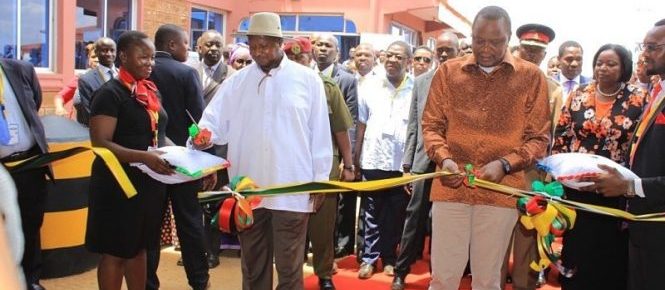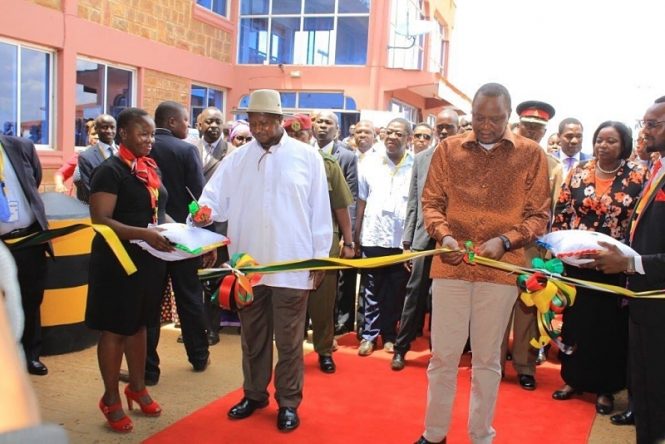Home > News >Efficient Border Crossing To Boost Trade Between Kenya And Uganda

Efficient Border Crossing To Boost Trade Between Kenya And Uganda • 2018-03-05
President of the Republic of Kenya, H.E. Uhuru Kenyatta, and H.E. Yoweri Kaguta Museveni, President of the Republic of Uganda, joined by Ambassador Liberat Mfumukeko, African Community Secretary General, officially launched the Busia One Stop Border Post (OSBP) located on the Kenya/Uganda border last Saturday.
Construction of the Busia OSBP was carried out with funding of US$11.7 million from the United Kingdom through the Department for International Development (DFID), while the systems and other related soft infrastructure (equivalent to US$1.2 million) was funded by Global Affairs, Canada. The OSBP investment includes office buildings, roads and parking yards, cargo verification bays, scanner shed, passenger sheds, targeting booths, warehouse and canopies, ICT networks and hardware, furniture, and institutional support to the border agencies.
The OSBP ensures effective border control mechanisms are in place. It will boost trade by cutting the time taken to clear goods between the two nations, thus contributing to a reduction in transport costs, whilst increasing volumes of transhipment cargo through the Central Corridor. It is expected that time to cross the border will reduce by at least a third.
An OSBP is a “one stop” form of border crossing point jointly managed by adjoining Partner States, where multiple border agencies cooperate and collaborate with each other, and effectively coordinate their activities to maximise their operational efficiency. The OSBP arrangement brings together all the government agencies performing border crossing controls procedures under one roof – doing away with need for motorised traffic and persons to undergo clearance twice at both sides of the border. This arrangement expedites movement, release and clearance of goods and persons across borders, by streamlining border procedures, automation of the border processes and simplification of trade documents.

Speaking at the event, Uganda president H.E Yoweri Museveni said, “I want to thank the British government who have supported us through TMA in the construction of the one stop border post, making it easy to cross the borders and to do business with Kenya. Trade is a means that will help us create prosperity for the people. My government is committed to creating wealth and jobs for the people through the creation of enabling environments for services, Information Communication Technology, commercial agriculture and industries.”
Addressing the crowd, Kenyan President H.E Uhuru Kenyatta commended TMA for its support to the government and underscored the importance of the OSBP saying, “This facility is an important link for ease of trade between our two countries. Uganda continues to be an important trading partner for Kenya. Opportunities for increased trade and investment have been created. I am happy to hear that because of this OSBP here in Busia, our revenue authority has been able to collect more revenues, a clear indication of increased trade flows.”
EAC SG Ambassador Liberat Mfumukeko: “Much as the One Stop Border concept may look new to some people, the framers of our integration instruments envisioned the need for these facilities and embedded them in the EAC Customs Union Protocol at the time of its negotiation. The first OSBP operation was at Malaba railway station between Uganda and Kenya over ten years ago. At the same time, Customs Departments having realised that multiple examination of goods at our internal borders was wasteful and caused unnecessary costs to business, started joint examination of cargo of which Busia Border was a pioneer. These pilot programmes provided a practical justification for upscaling the One Stop Border program in the entire region.”
UKAID has provided over US$52 million to the African Transit Improvement Programme (EATIP) through TMA, as a contribution to the World Banks’ Africa Trade and Transport Facilitation Project (EATTFP).
The Head of DFID Kenya, Pete Vowles said, “The UK government is proud to have made such an important contribution to improving regional trade in Africa through our establishment and leadership of Trade Mark Africa. By cutting red tape, reforming customs processes and improving roads, ports, and border posts, the UK is supporting the creation of an environment essential for businesses to grow and trade with each other. The completion of the Busia border post marks an important milestone towards our goal of reducing by a third the time to import from the EAC and the rest of the world.”
Over the years, delays in cross border clearance were attributed to duplication of handling procedures on either side of the border, poor institutional arrangement and cargo management systems inadequate physical infrastructures and services and immigration management. The new established OSBP has already addressed some of these challenges. Surveys indicate that since operationalisation of the OSBP early this year, the average time to cross the Busia border has reduced by 84%.
TMA CEO Frank Matsaert, said, “The completion and operationalisation of the Busia OSBP is a crucial milestone in increasing access to markets and the facilitation of the movement of cargo along the Northern Corridor. When initially investing US$12 million with our donors, the United Kingdom and Canada, greater access to markets, increased efficiency that would reduce costs by reducing time and improved infrastructure were just a few of our end goals. Ultimately, our projects in physical infrastructure and automation of key government trade processes like customs, have complemented each other to reduce the cost of doing business and boost trade volumes, increasing both Kenya’s and Uganda’s overall trade competitiveness. Most importantly, they have contributed to governments, being businesses, being able to expand thus creating jobs.”
TMA, through its donors and in partnership with the Africa Community, has to date supported 15 OSBPs in Africa including South Sudan, and has invested about US$117 million in OSBPs and access roads. They are: Kenya and Uganda’s Busia/Busia, Kenya and Uganda’s Malaba/Malaba, Rwanda and Uganda’s Kagitumba/Mirama Hills, Tanzania and Uganda’s Busia border happens to be one of the busiest in Africa handling transit to and from Great Lakes region of Rwanda, Burundi, DRC and South Sudan.
Based on a recent TMA independent Time and Traffic Survey, the total weekly traffic count at Busia Kenya is 3,324 vehicles and 1,784 for Busia Uganda. Most importantly, this border handles the largest number of informal cross border traders in the EAC.
Source: Railways Africa

